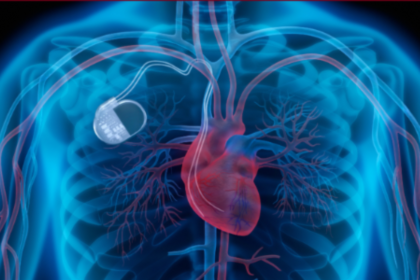A new study published in JAMA Cardiology by UVM cardiovascular medicine fellow Margaret Infeld, M.D., M.S., and colleagues found evidence that by implementing a tailored acceleration of heart rates, they could reduce congestion and improve the circulation of blood in heart failure patients with "stiff" hearts.

Image features an X-ray-type view of an adult upper torso showing skeletal bones, a heart connected to a pacemaker, lung bronchi, arteries and veins. (Stock image)
More than 75 million Americans have high blood pressure accompanied by heart muscle thickening and more than three million of these patients suffer from heart failure, a leading cause of hospital admissions and healthcare costs. In heart failure with a stiff heart muscle, the heart is less able to relax and refill with blood, which often causes debilitating shortness of breath. A new study published in JAMA Cardiology found evidence that a counterintuitive approach might be the key to addressing this problem, which is a diverse multisystem disease with few available therapies.
Heart failure occurs when the heart cannot adequately meet the body’s demands. About half of heart failure patients have a stiff heart with a normal pumping function but poor heart muscle relaxation — known as heart failure with a preserved ejection fraction (HFpEF). The other half of heart failure patients have an enlarged and weak heart with a reduced pumping function, called heart failure with a reduced ejection fraction. This condition has many effective therapies.
“We have tried the same medications that work for weak heart failure with limited success,” said senior author Markus Meyer, M.D., Ph.D., associate professor at the University of Minnesota (U of M) Medical School and Lillehei Heart Institute and an adjunct associate professor at the University of Vermont (UVM). “For example, beta-blockers save many lives in weak heart failure, but in patients with stiff hearts, they may be harmful by slowing the heart rate and increasing the congestion of blood in the heart,” he added.
“In this study, we tested whether selectively speeding up the heart rate to a more normal rate at rest with pacemakers helps these patients,” said first author and lead investigator Margaret Infeld, M.D., M.S., a cardiac electrophysiology fellow and clinical instructor at UVM’s Larner College of Medicine.
Based on the results of this blinded, randomized clinical trial, called myPACE, the researchers learned that by implementing a tailored acceleration of heart rates, they could reduce congestion and improve the circulation of blood. A total of 107 HFpEF patients from Vermont, New Hampshire, and New York who have very specific kinds of pre-existing pacemakers participated in the study.
“This study provides incremental evidence that higher heart rates — within the normal range — and not lower heart rates may be beneficial for patients with preclinical or overt HFpEF,” said Infeld, who is a Vermont Center on Cardiovascular and Brain Health Pipeline Development Program investigator.
The research team sought to explore if raising the pacemaker rate to a more normal resting rate, based on patient body size, would improve outcomes in patients with stiff hearts. The patients who were paced at faster heart rates reported feeling markedly better and were less congested. In addition, patients were more active and had less atrial fibrillation — a common heart rhythm disorder associated with heart failure.
“These results are provocative,” said Daniel Lustgarten, M.D., Ph.D., a UVM professor of medicine and coauthor of the study. “It is very important to emphasize that the pacemakers in this study were implanted in a way that is very different from traditional pacemakers; traditional pacemakers would likely not show these benefits and, in fact, could even be harmful in some patients.”
"It is extremely rare for a trainee to lead a randomized clinical trial of this scale. Dr. Infeld's commitment to this research and to heart failure patients has been amazing," said Mary Cushman, M.D., M.Sc., professor and vice chair for emerging researchers in the UVM Department of Medicine.
The research team believes these promising findings warrant further research to confirm the safety and benefits of this new treatment approach. They plan to continue studying the optimal pacing rates and confirm their results in extensive studies that involve many medical centers.
###
This study was supported by The Heart Rhythm Society Research Fellowship Award, the Martin M. LeWinter Young Investigator Award, and the Early Career Research Award through the Cardiovascular Research Institute of Vermont (M. Infeld), grant R01 HL-122744, the University of Minnesota start-up funds, and the Engdahl Family Chair for Heart Failure Research (M.460 Meyer).
(This article was adapted from a press release written by Ezra Xiong, communications specialist, U of M Medical School)